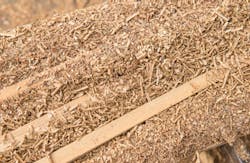Researchers in Belgium have found a way of turning sawdust into building blocks for gasoline.
A new chemical process developed at KU Leuven's Centre for Surface Chemistry and Catalysis converts the cellulose in sawdust into hydrocarbon chains. These hydrocarbons can be used as an additive in gasoline, or as a component in plastics, the university said.
"Essentially, the method allows us to make a 'petrochemical' product using biomass — thus bridging the worlds of bio-economics and petro chemistry," commented Dr. Bert Lagrain, co-author of the research report.
Cellulose is present in all non-edible plant parts of wood, straw, grass, cotton and old paper. A key advantage of cellulose is that it is essentially plant waste and does not compete with food crops in the way that crops grown for bioethanol do.
"At the molecular level, cellulose contains strong carbon chains. We sought to conserve these chains, but drop the oxygen bonded to them, which is undesirable in high-grade gasoline. Our researcher Beau Op de Beeck developed a new method to derive these hydrocarbon chains from cellulose," explained Professor Bert Sels.
"With the right temperature and pressure, it takes about half a day to convert the cellulose in the wood shavings into saturated hydrocarbon chains, or alkanes," said Dr. Lagrain.
The result is an intermediary product that requires one last simple step to become fully-distilled gasoline, Prof. Sels added.
As well as its potential use as an eco-friendly additive that can replace a portion of traditionally-refined gasoline, the green hydrocarbons could be used in the production of ethylene, propylene and benzene — the building blocks for products such as plastic, rubber, insulation foam, nylon and coatings.
The researchers currently have a patent pending for this new type of bio-refining.
Details of their discovery have been published in the journal Energy & Environmental Science.
